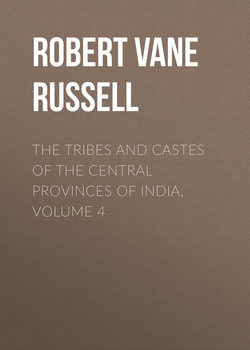Читать книгу The Tribes and Castes of the Central Provinces of India, Volume 4 - Robert Vane Russell - Страница 49
Part II
Articles on Castes and Tribes
Kumhār—Yemkala
Vol. IV
Kurmi
10. Other ceremonies
ОглавлениеAfter the wedding the bride and bridegroom resume their seats and the parents of the bride wash their feet in a brass tray, marking their foreheads with rice and turmeric. They put some silver in the tray, and other relations and friends do the same. The presents thus collected go to the bridegroom. The Chandnāhu Kurmis then have a ceremony known as palkachār. The bride’s father provides a bed on which a mattress and quilt are laid and the bride and bridegroom are seated on it, while their brother and sister sprinkle parched rice round them. This is supposed to typify the consummation of the marriage, but the ceremony is purely formal as the bridal couple are children. The bridegroom is given two lamps and he has to mix their flames, probably to symbolise the mixing of the spirits of his wife and himself. He requires a present of a rupee or two before he consents to do so. During the wedding the bride is bathed in the same water as the bridegroom, the joint use of the sacred element being perhaps another symbolic mark of their union. At the feasts the bride eats rice and milk with her husband from one dish, once at her own house and once after she goes to her husband’s house. Subsequently she never eats with her husband but always after him. She also sits and eats at the wedding-feasts with her husband’s relations. This is perhaps meant to mark her admission into her husband’s clan. After the wedding the Brāhmans on either side recite Sanskrit verses, praising their respective families and displaying their own learning. The competition often becomes bitter and would end in a quarrel, but that the elders of the party interfere and stop it.
The expenses of an ordinary wedding on the bridegroom’s side may be Rs. 100 in addition to the bride-price, and on the bride’s Rs. 200. The bride goes home for a day or two with the bridegroom’s party in Chhattīsgarh but not in the northern Districts, as women accompany the wedding procession in the former but not in the latter locality. If she is too small to go, her shoes and marriage-crown are sent to represent her. When she attains maturity the chauk or gauna ceremony is performed, her husband going to fetch her with a few friends. At this time her parents give her clothes, food and ornaments in a basket called jhanpi or tipara specially prepared for the occasion.
